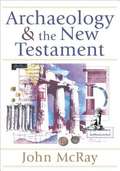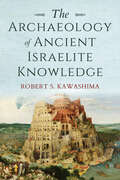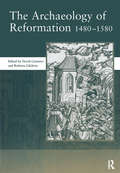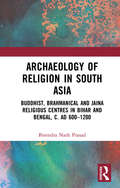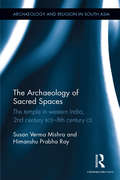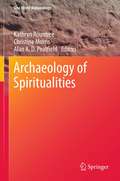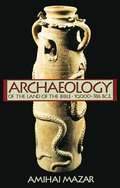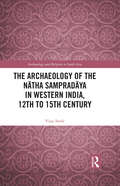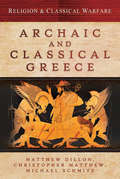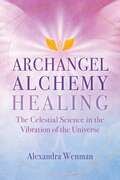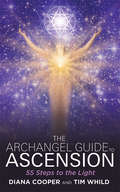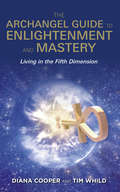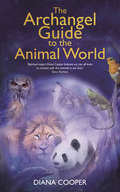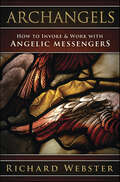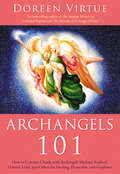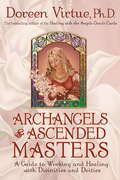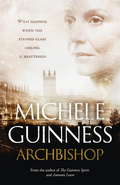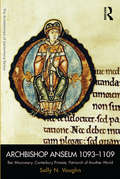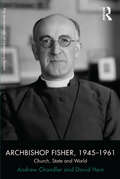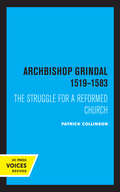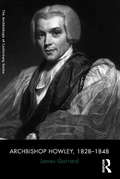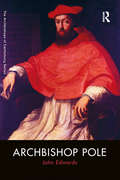- Table View
- List View
Archaeology and the New Testament
by John McRayAs he tours sites associated with the ministry of Jesus, the journey of Paul, and the seven churches of Revelation, he shows the pervasive influence of society, architecture, and religion on the peoples of the first century and on the New Testament.
The Archaeology of Ancient Israelite Knowledge (Biblical Literature)
by Robert S. KawashimaThe Archaeology of Ancient Israelite Knowledge reconstructs in carefully researched detail the worldview of the ancient Israelites writers responsible for the Hebrew Bible. What was the role of God in their lives? How did they see the relationship between God, nature, and themselves? Contrary to prevailing scholarly understanding, Robert Kawashima argues that the ancient Israelites saw God in a radically different way than the peoples around them. God no longer interconnected everything—humans, nature—but became seen as sharply separated from nature.Elegantly written and powerfully argued, The Archaeology of Ancient Israelite Knowledge is essential reading for anyone wanting to grasp the Hebrew Bible and the ancient world that gave rise to it.
The Archaeology of Reformation,1480-1580 (The\society For Post-medieval Archaeology Monographs)
by David GaimsterTraditionally the Reformation has been viewed as responsible for the rupture of the medieval order and the foundation of modern society. Recently historians have challenged the stereotypical model of cataclysm, and demonstrated that the religion of Tudor England was full of both continuities and adaptations of traditional liturgy, ritual and devoti
Archaeology of Religion in South Asia: Buddhist, Brahmanical and Jaina Religious Centres in Bihar and Bengal, c. AD 600–1200
by Birendra Nath PrasadIn the religious landscape of early medieval (c. AD 600-1200) Bihar and Bengal, poly-religiosity was generally the norm than an exception, which entailed the evolution of complex patterns of inter-religious equations. Buddhism, Brahmanism and Jainism not only coexisted but also competed for social patronage, forcing them to enter into complex interactions with social institutions and processes. Through an analysis of the published archaeological data, this work explores some aspects of the social history of Buddhist, Brahmanical and Jaina temples and shrines, and Buddhist stūpas and monasteries in early medieval Bihar and Bengal. This archaeological history of religions questions many ‘established’ textual reconstructions, and enriches our understanding of the complex issue of the decline of Buddhism in this area. Please note: Taylor & Francis does not sell or distribute the Hardback in India, Pakistan, Nepal, Bhutan, Bangladesh and Sri Lanka.
The Archaeology of Sacred Spaces: The temple in western India, 2nd century BCE–8th century CE (Archaeology and Religion in South Asia)
by Susan Verma Mishra Himanshu Prabha RayThis volume focuses on the religious shrine in western India as an institution of cultural integration in the period spanning 200 BCE to 800 CE. It presents an analysis of religious architecture at multiple levels, both temporal and spatial, and distinguishes it as a ritual instrument that integrates individuals and communities into a cultural fabric. The work shows how these structures emphasise on communication with a host of audiences such as the lay worshipper, the ritual specialist, the royalty and the elite as well as the artisan and the sculptor. It also examines religious imagery, inscriptions, traditional lore and Sanskrit literature. The book will be of special interest to researchers and scholars of ancient Indian history, Hinduism, religious studies, architecture and South Asian studies.
Archaeology of Spiritualities (One World Archaeology)
by Alan A. Peatfield Christine Morris Kathryn RountreeArchaeology of Spiritualties provides a fresh exploration of the interface between archaeology and religion/spirituality. Archaeological approaches to the study of religion have typically, and often unconsciously, drawn on western paradigms, especially Judaeo-Christian (mono)theistic frameworks and academic rationalisations. Archaeologists have rarely reflected on how these approaches have framed and constrained their choices of methodologies, research questions, hypotheses, definitions, interpretations and analyses, and have neglected an important dimension of religion: the human experience of the numinous - the power, presence or experience of the supernatural. Within the religions of many of the world's peoples, sacred experiences - particularly in relation to sacred landscapes and beings connected with those landscapes - are often given greater emphasis, while doctrine and beliefs are relatively less important. Archaeology of Spiritualities asks how such experiences might be discerned in the archaeological record; how do we recognize and investigate 'other' forms of religious or spiritual experience in the remains of the past? The volume opens up a space to explore critically and reflexively the encounter between archaeology and diverse cultural expressions of spirituality. It showcases experiential and experimental methodologies in this area of the discipline, an unconventional approach within the archaeology of religion. Thus Archaeology of Spiritualities offers a unique, timely and innovative contribution, one that is also challenging and stimulating. It is a great resource to archaeologists, historians, religious scholars, and others interested in cultural and religious heritage.
The Archaeology of the Holy Land
by Jodi MagnessThis book provides an introduction to the archaeology and history of ancient Palestine - modern Israel, Jordan, and the Palestinian territories - from the destruction of Solomon's temple in 586 BCE to the Muslim conquest in 640 CE. Special attention is paid to the archaeology of Jerusalem and the Second Temple period, in the time of Herod the Great and Jesus. For each period, the book offers a historical background for the Mediterranean world and the ancient Near East, as well as the events in Palestine. Major sites such as Masada, Caesarea Maritima, and Petra are examined in archaeological and historical detail, along with the material culture - coins, pottery, glass, and stone vessels - of each period. This book provides a thorough overview of the archaeology of this historically vibrant part of the world.
Archaeology of the Land of the Bible
by Amihai MazarNotes to Reader: I did not read this carefully to correct. I did format the table of contents so it would be readable; put in page breaks, making sure that no first or last lines of the page were missing and that they followed as they should; scanned and put in missing pages and deleted duplicated pages; described some of the illustrations ( descriptions in brackets are mine). I had the spell-check on as I went, so where I found errors I corrected them but actually it was a very good scan. I did nothing with the indices or end-of-chapter notes. I think they're readable as they are-the scanner seems to have validated them--but if anyone reading this book needs anything fixed let me know and I'll get the book. Whoeveer scanned and submitted this book did an excellent job. Cindy-popularplace@yahoo.com
The Archaeology of the Nātha Sampradāya in Western India, 12th to 15th Century (Archaeology and Religion in South Asia)
by Vijay SardeThis book studies Nātha sampradāya through archaeological evidence for the first time. Drawing on a pioneering approach to the study of ascetic traditions, it investigates not only the nature of the Nātha sampradāya’s religious architecture but also examines the extent to which they shared space with other religious groups such as the devotees of Siva and Sakti, Buddhism, and Islam, especially with the Sufi tradition. Focusing on western India, the book sifts through a variety of archaeological evidence and documentation of their temples, caves, and maṭhas. It critically analyses iconographic representations of ascetics on temple walls and sculptural representations of yogic postures or āsanas. Further, these representations are discussed within a pan-South Asian framework to highlight both the commonalities of the tradition across the subcontinent and the regional specificities, along with their chronological spread. Breaking new ground, this volume will be of great interest to scholars and researchers of religion, especially Hinduism, history, archaeology, and South Asian studies.
An Archaeology of the Soul: North American Indian Belief and Ritual
by Robert L. HallThis book describes North American Indian beliefs and rituals. It also includes bibliographical references and an index.
Archaic and Classical Greece (Religion & Classical Warfare)
by Matthew Dillon Christopher Matthew Michael SchmitzEssays examining the influence of gods, oracles, and omens in the wars of the Archaic and Classical Greek world.Religion was integral to the conduct of war in the ancient world and the Greeks were certainly no exception. No campaign was undertaken, no battle risked, without first making sacrifice to propitiate the appropriate gods (such as Ares, god of War) or consulting oracles and omens to divine their plans. Yet the link between war and religion is an area that has been regularly overlooked by modern scholars examining the conflicts of these times. This volume addresses that omission by drawing together the work of experts from across the globe. The chapters have been carefully structured by the editors so that this wide array of scholarship combines to give a coherent, comprehensive study of the role of religion in the wars of the Archaic and Classical Greek world.Aspects considered in depth will include: Greek writers on religion and war; declarations of war; fate and predestination, the sphagia and pre-battle sacrifices; omens, oracles and portents, trophies and dedications to cult centers; militarized deities; sacred truces and festivals; oaths and vows; religion & Greek military medicine.Praise for Religion & Classical Warfare: Archaic and Classical Greece“Comprised of ten erudite and impressively informative articles by experts in the field of Greek antiquity. . . . A work of meticulous and detailed scholarship, Religion & Classical Warfare: Archaic and Classical Greece must be considered as a core addition to community, college, and university library Antiquarian Greek History collections and supplemental curriculum studies lists.” —Midwest Book Review
Archangel Alchemy Healing: The Celestial Science in the Vibration of the Universe
by Alexandra Wenman• Details the practice of Archangel Alchemy, an angelic energy healing therapy, including its protocols, invocations, and hands-on techniques• Looks at how and why the science of Archangel Alchemy works as a healing modality, backed up by scientific research• Provides channeled guidance, meditations, attunements, and healing practices to connect you with your true angelic nature for healing, harmonizing, and connecting with your soul purposeChanneled directly through the Archangels, primarily Gabriel and Metatron, Archangel Alchemy is an angelic energy healing system that aligns you with the angelic kingdom and allows you to connect with your purest divine blueprint. Providing meditations, invocations, channeled guidance, and healing practices, Alexandra Wenman shows you how to tap into your own magical and healing gifts by experiencing and embodying angelic qualities and vibrations. Learn about key concepts such as the holographic nature of the soul; light language and its symbols; how to establish the pillar of light and the diamond shield; and how to open the gateway to the multidimensional self. You will find attunements to Ascended Masters, the new Elohim Angels, and the great cosmic heart. Presenting evidence to support the existence of the angelic kingdom, and of life and the myriad of dimensions beyond our physical reality, Alexandra draws on scientific research from quantum physics and the sacred geometry of nature, as well as psychology and metaphysics, to show how and why Archangel Alchemy healing works.With numerous practical applications, this comprehensive guide enables anyone to harness the power of angelic energies to heal, harmonize, and fully align with your soul purpose.
The Archangel Guide to Ascension: 55 Steps to the Light
by Diana Cooper Tim WhildTwo leading spiritual teachers share new, high-frequency ascending information—so that you can accelerate your journey to the light Since 2012, the energy on this planet has changed considerably, with much more high-frequency energy coming in. In addition, many of the tools and techniques we have been using on the ascension path have moved to a new vibration with different geometric set-ups. Diana Cooper and Tim Whild have been working with the angels for many years and believe that people are ready to receive this higher-level information. The Archangels are stepping in to help you to ascend your frequency to the fifth dimension and beyond. In The Archangel Guide to Ascension, they offer clear steps to accelerate your journey to the light. These steps are sequential so that your path will be smooth and clear. Each chapter offers guidance about the Archangels, information about the step you are on, and a visualization to assist you. Archangel Metatron, who vibrates with the number 55, is overlighting the whole book, and will be with you as you work with the guidance it offers.
The Archangel Guide to Enlightenment and Mastery: Living in the Fifth Dimension
by Diana Whild Tim WhildThis book offers the reader information, exercises and meditations to become an enlightened master in this lifetime. Diana Cooper and Tim Whild explain why this twenty-year period offers an unprecedented opportunity for spiritual growth, and to help you take advantage of this, they connect you to the highest frequency dragons, unicorns, angels and great ascended masters from all over the universe, who are assisting you to move into your true potential. For the first time since the golden era of Atlantis those who are ready can be bathed in ninth-dimensional frequencies. The entire book vibrates at the fifth to seventh dimension, interwoven with incredible shining ninth-dimensional threads. Lord Kuthumi, the world teacher, takes you into his twelve teaching temples, where he and great universal angels and masters take you on a training course into enlightenment and mastery. In addition, many of the greatest masters ever to serve our planet share their secrets and assistance. Lord Voosloo, the highest frequency high priest to have served in Atlantis has allowed us to access his incredible energy to take the reader to the highest levels now achievable on planet Earth. This book is a must-have read for those who wish to fulfill their soul missions in this life and serve Gaia in the fifth dimension and beyond.
The Archangel Guide to the Animal World
by Diana CooperJust like humans, each type of animal has its own soul purpose on Earth. Birds, fish, insects and reptiles are on their own spiritual journey. Some animals incarnate in service to humanity, while others serve the planet or are here to grow spiritually through life on Earth. The souls of animals, like the souls of humans, come from different stars or planets, even from different universes.In this book, which features unprecedented teachings on the animal realm, Diana Cooper shares fascinating channelled information about the soul missions and service work of many of the creatures of the world. We discover the various planets or stars from which they originate and what they come to Earth to learn or teach.As well as comprehensive material about the creatures with whom we share the planet and the particular angels they work with, this incredible book contains visualizations to connect with them and prayers to help them all.The Archangel Guide to the Animal World will expand your consciousness and help you see to the animal world with enlightened eyes.
Archangels: How to Invoke & Work with Angelic Messengers
by Richard WebsterTransform Your Life with the Power and Grace of Divine MessengersAs beings of pure light who possess great influence, archangels can help you achieve your goals and develop a closer relationship with the Divine. Drawing from multiple spiritual paths, bestselling author Richard Webster introduces you to the four most-recognized archangels—Michael, Raphael, Gabriel, and Uriel—as well as numerous lesser-known angels who are rarely featured in other books. You will also learn simple meditations and rituals to help you communicate and work with them for protection, guidance, and wisdom.This concise and conversational guide describes the hierarchy of angels and the unique responsibilities for each one. With detailed information on correspondences for each archangel, including crystal, essential oil, element, zodiac sign, and chakra, you'll discover which ones to connect with and how they can support you. Featuring affirmations, invocations, dream work, and more, this book makes it easy to seek angelic assistance and enjoy a life filled with peace, harmony, and divine love.
Archangels 101: How To Connect Closely With Archangels Michael, Raphael, Uriel, Gabriel And Others For Healing, Protection, And Guidance
by Doreen VirtueLegions of loving and trustworthy archangels watch over us, and you can develop an even closer relationship with them by learning their names and specialties. In this uplifting nondenominational book, Doreen Virtue guides you in connecting with her 15 favorite archangels; and you’ll read true stories from people who received protection, miraculous healings, and amazing guidance from these beloved heavenly beings. Archangels want to help each and every one of you live healthier and happier lives. As unlimited beings, archangels can assist everyone simultaneously, and this fascinating book will teach you which archangels to call upon for various situations. Whether you’re new to working with angels, or someone who has believed in angels all your life, you’ll want to refer to Archangels 101 again and again.
Archangels & Ascended Masters: A Guide To Working And Healing With Divinities And Deities
by Doreen VirtueArchangels and Ascended Masters is a thoroughly researched book in a lively encyclopedia format, listing 77 divinities from Greek, Roman, Egyptian, Asian, Babylonian, Tibetan, Buddhist, Celtic, Theosophical, New Age, Catholic, Cabalistic, Jewish, and Christian roots. Doreen carefully studied and wrote about the history of each deity, what role they serve today, how they can help us with specific life problems, and how to call upon each one. <p><p>Doreen spent time in communication with each divinity to ensure that the being was reachable, and to discover the essence of his or her personality and current dealings with the world—and within these pages, she includes a channeled message or impression from each of the ascended masters and archangels. Many of her channelings were conducted at power points throughout the world, such as Stonehenge in England; the Irish coast; Kona, Hawaii; and the New Zealand rain forest. <p><p>A comprehensive chart lists a number of life situations, such as Addictions, Finding a Soulmate, Emergency Money, Healing Physical Illness, and various personal and family concerns. Beneath each topic is the list of whom to call upon when dealing with that particular challenge. Doreen also includes prayers to call upon multiple divinities for specific issues such as "increased clairvoyance" and "resolving conflict."
Archbishop: A Novel
by Michele GuinnessFive years from now, the Church of England is on its knees. Yet one woman is making a difference, and when she is appointed Archbishop of Canterbury, anything could happen.Vicky Burnham-Woods is a master of diplomacy, and deeply committed to bringing the church back into the heart of community and cultural life - but not everyone wants a woman at the top, and behind the scenes dark forces are moving.Can the first ever female Archbishop of Canterbury last long enough to achieve her mission?
Archbishop: A novel
by Michele GuinnessFive years from now, the Church of England is on its knees. Yet one woman is making a difference, and when she is appointed Archbishop of Canterbury, anything could happen.Vicky Burnham-Woods is a master of diplomacy, and deeply committed to bringing the church back into the heart of community and cultural life - but not everyone wants a woman at the top, and behind the scenes dark forces are moving.Can the first ever female Archbishop of Canterbury last long enough to achieve her mission?
Archbishop Anselm 1093–1109: Bec Missionary, Canterbury Primate, Patriarch of Another World (The Archbishops of Canterbury Series)
by Sally N. VaughnSt Anselm's archiepiscopal career, 1093-1109, spanned the reigns of two kings: William Rufus and the early years of Henry I. As the second archbishop of Canterbury after the Norman Conquest, Anselm strove to extend the reforms of his teacher and mentor at Bec, and his predecessor at Canterbury, Archbishop Lanfranc. Exploring Anselm's thirty years as Prior and Abbot of the large, rich, Norman monastery of Bec, and teacher in its school, this book notes the wealth of experiences which prepared Anselm for his archiepiscopal career--in particular Bec's missionary attitude toward England. Sally Vaughn examines Anselm's intellectual strengths as a teacher, philosopher and theologian: exploring his highly regarded theological texts, including his popular Prayers and Meditations, and how his statesmanship was influenced as he dealt with conflict with the antagonistic King William Rufus. Vaughn argues that Rufus's death influenced Anselm's rivalry with King Henry I and fostered a more subdued and civil conflict between Anselm and Henry which ended with cooperation between king and archbishop at the end of Anselm's life. King and archbishop became’yoked together as two oxen pulling the plow of the church through the land of England’. Anselm’s final years at the pinnacle of power reveal a superb administrator over Canterbury and Primate over the churches of all Britain, in which position his followers described him as 'Pope of another world'. The final section includes a selection of original source material including archiepiscopal letters drawn primarily from Lambeth Palace Library.
Archbishop Fisher, 1945–1961: Church, State and World (The Archbishops of Canterbury Series)
by Andrew Chandler David HeinArchbishop Fisher’s archiepiscopate reflected the central issues of his time and place. It was Fisher who oversaw an immense programme of reforms which effectively recast the institutions of the Church of England for generations to come. It was Fisher who proved to be the essential architect, politician and diplomat behind the creation of a worldwide Anglican Communion. His determination to promote the development of relations with other churches produced a vital contribution to the cause of ecumenism, which culminated in his momentous meeting with Pope John XXIII. Archbishop Fisher was a vigorous participant in the questions which defined national and international life. This book explores Fisher’s influence on major contemporary issues and events, including divorce-law reform and capital punishment at home and the end of Empire and the most dangerous years of the Cold War abroad. This new biography establishes the continuing significance not only of the office of Archbishop in the Church but also of the Church at large in the tumultuous world of the later twentieth century. A final section of original source material includes letters, sermons and other writings bringing vividly to life the range and character of Fisher's public and private role.
Archbishop Grindal, 1519-1583: The Struggle for a Reformed Church
by Patrick CollinsonThis title is part of UC Press's Voices Revived program, which commemorates University of California Press’s mission to seek out and cultivate the brightest minds and give them voice, reach, and impact. Drawing on a backlist dating to 1893, Voices Revived makes high-quality, peer-reviewed scholarship accessible once again using print-on-demand technology. This title was originally published in 1977.
Archbishop Howley, 1828-1848 (The Archbishops of Canterbury Series)
by James GarrardWilliam Howley, Archbishop of Canterbury 1828-1848, led the Church of England during the beginning and expansion of the Oxford Movement, at a time when the precursor to the Church Commissioners was established, and during the momentous debates and decisions in Parliament which saw the final retreat from the myth of an all Anglican legislature. Howley’s chairmanship of the commissions of the 1830s and 1840s which began the gargantuan task of reforming the Church’s practices and re-arranging its finances, made him an object of fury and scorn to some of those who benefited from things as they were, most especially in the cathedrals. Exploring the central events and debates within the Church of England in the first half of the nineteenth century, this book draws on primary and secondary evidence about Howley’s career and influence. A section of original sources, including his Charges and other public documents, correspondence and speeches in the House of Lords, places Howley’s achievements in proper context and illustrates his prevailing concerns in education, the establishment and political reform, relationships with the Tractarians, and in the early stages of Church reform. Dealing thematically with many of the issues faced by Howley, and exploring his own High Church theological views in historical context, James Garrard offers a fruitful re-appraisal of the intellectual, spiritual and ’party’ context in which Howley moved.
Archbishop Pole (The Archbishops of Canterbury Series)
by John EdwardsThis fresh exploration of the life, work and writing of Archbishop Pole, focuses particularly on Pole’s final years (1556-58) as Archbishop of Canterbury. Fully integrating Pole’s English and Continental European experiences, John Edwards places these in their historical context and signposts lessons for contemporary issues and concerns. Stressing the events and character of Pole's 'English' life, up to his exile in the 1530s, as well as in his final years in England (1554-58), this book explores his close relationship, both genealogical and emotional, with Henry VIII and Mary I. Portraying Pole as a crucial figure in the Catholic-Protestant division, which still affects Britain today, this book details the first, and so far last, attempt to restore Roman Catholicism as the 'national religion' of England and Wales by telling the life-story of the hinge figure in forging English religious and political identity for several centuries. The final section of this book draws together important and illuminating source material written by Pole during his years as Archbishop of Canterbury.
